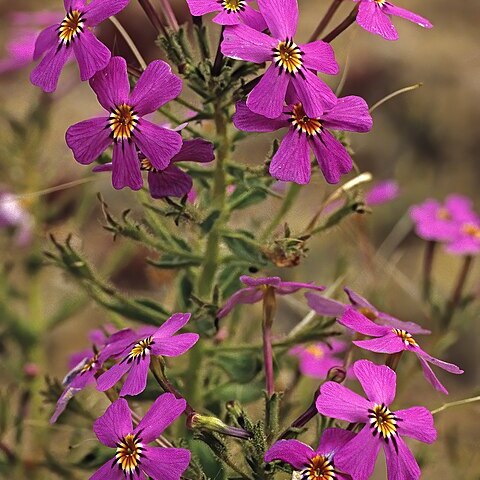Annual (or possibly perennating) herb, stems 20-450 mm tall, up to 8 mm diam. at base, erect, simple but soon sparingly branched from the base and above, glandular-pubescent, hairs up to 0.8-2 mm long, up to 0.2-0.4 mm across flattened base, heads c. 0.1-0.2 mm in diam., leafy. Leaves opposite but quickly alternate upwards, up to 18-45 x 8-30 mm, blade of largest leaves ovate abruptly contracted to a petiolar part up to roughly 1/3 total leaf length, uppermost leaves elliptic or narrowly ovate and more gradually tapered, apex acute, margins serrate, teeth up to 3 mm long, both surfaces glandular-pubescent, hairs up to 0.5-1 mm long, small scattered glistening glands as well. Flowers solitary in each leaf axil, almost from base of plant, capable of forming very stout and crowded pseudoracemes. Pedicels up to 25-60 mm long, glandular-pubescent, hairs up to 0.5-1 mm long, some very stout, up to 0.25 mm across flattened base, heads up to 0.15 mm across. Calyx tube 0.25-0.4 mm long, lobes 5.5-8.5 x 0.7-0.8 mm, linear-oblong, glandular-pubescent, hairs up to 0.25-0.8 mm long. Corolla tube 16-24 x 2.5-2.8 mm in throat, cylindric, abruptly expanded near apex, mouth somewhat compressed laterally, limb nearly regular, 14-17 mm across lateral lobes, posticous lobes 5-7.4 x 3.5-6 mm, anticous lobe 5-7.5 x 4-6 mm, all lobes cuneate, ± truncate or emarginate, glandular-puberulous outside, hairs c. 0.1 mm long, transverse band of clavate hairs in throat extending very briefly onto base of anticous lip, lobes mauve, lilac, rose or white, throat orange/yellow, the colour extending out around the mouth, 3 median deep violet bars near base of each lobe. Stamens: posticous filaments 2-3 mm long, glandular-puberulous, anthers 1.4-2 mm, anticous filaments 0.1-0.2 mm long, anthers greatly reduced, 0.1-0.2 mm long, or rarely anticous stamens aborted. Stigma 1-1.2 mm long. Style 13.5-21 mm. Ovary 3-4 x 1.2-1.8 mm. Capsules 7.5-11 x 3-4.5 mm, glandular-puberulous. Seeds c. 0.3-0.7 x 0.2-0.3 mm. Flowering takes place principally between July and September, but there are scattered records between April and December.
More
Erect, aromatic, annual or perennial herb, 20-450 mm tall, glandularpubescent, hairs broad and flattened at base. Leaves ovate, serrate. Flowers in each leaf axil, often forming stout crowded pseudoracemes, corolla tube 16-24 mm long, limb nearly regular, mauve, lilac, rose or white with 3 deep violet bars near base, throat orange-yellow, mouth compressed laterally.

